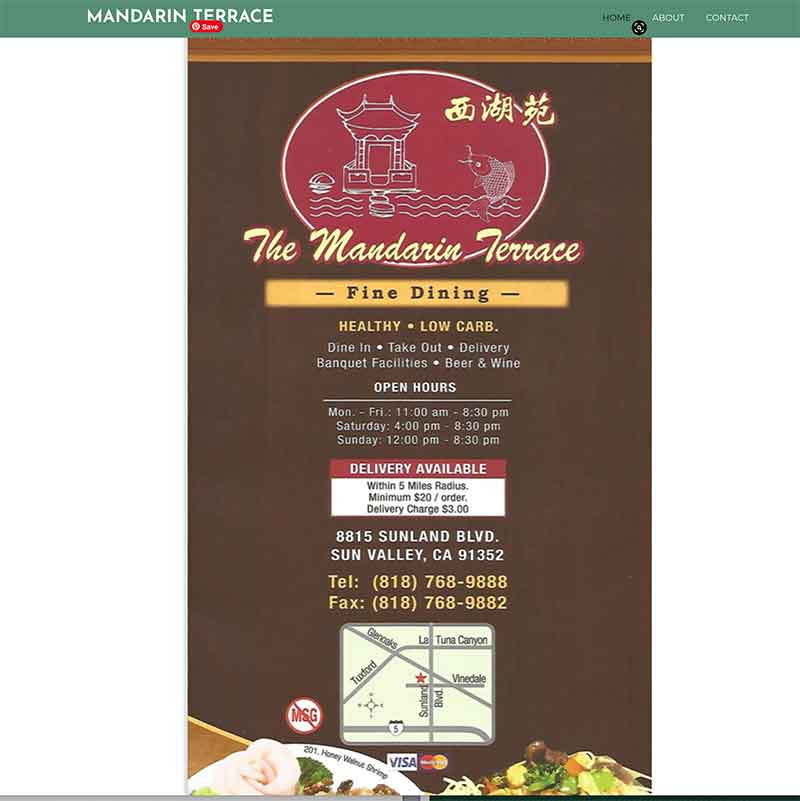Mandarin Terrace a Community Staple
Jose Mier has written of Sun Valley, CA restaurants before and it deserves reiterating that one of the best is our own Mandarin Terrace.

The history of Chinese food in America is a fascinating journey that spans more than a century and has significantly influenced the culinary landscape of the United States. It is a tale of immigration, adaptation, and the evolution of flavors that has left an indelible mark on American cuisine.
The story begins in the mid-19th century when Chinese immigrants first arrived in the United States, primarily drawn by the allure of the California Gold Rush. These early Chinese immigrants faced discrimination and challenging working conditions, often relegated to menial jobs such as mining and railroad construction. However, their rich culinary traditions and resourcefulness soon caught the attention of their fellow Americans.
The first Chinese restaurants in the United States emerged in cities with a significant Chinese immigrant population, such as San Francisco. One of the earliest recorded Chinese restaurants was the Canton Restaurant, which opened its doors in San Francisco in 1849. As more Chinese immigrants settled across the country, they began establishing restaurants to serve both their community and curious American patrons.
In the late 19th and early 20th centuries, Chinese restaurants faced challenges due to anti-Chinese sentiment and restrictive immigration laws, such as the Chinese Exclusion Act of 1882. Despite these obstacles, Chinese eateries persevered, adapting their menus to cater to American tastes while retaining elements of their authentic cuisine. Dishes like chop suey, widely considered the first Americanized Chinese dish, gained popularity during this time. It was a stir-fried medley of vegetables and meat, a dish that aimed to bridge the culinary gap between Chinese and American palates.
The early 20th century witnessed a growing interest in exoticism, and Chinese cuisine became en vogue among certain segments of American society. Chinese restaurants, often adorned with ornate decor and showcasing cultural elements, became fashionable dining destinations. The spread of Chinese cuisine was facilitated by the introduction of the fortune cookie at Japanese tea gardens and Chinese restaurants, adding an element of novelty to the dining experience.
The mid-20th century marked a significant turning point for Chinese food in America, with the widespread popularity of dishes like sweet and sour chicken, General Tso’s chicken, and egg rolls. This era saw the rise of the “Polynesian” and “tiki” restaurant trend, which blended elements of Chinese, Hawaiian, and other exotic cuisines. These restaurants, characterized by elaborate decor and often featuring tropical cocktails, became popular social hubs, further embedding Chinese-inspired dishes into the American culinary fabric.
The 1960s and 1970s saw a more profound appreciation for authentic Chinese cuisine. A wave of immigration from Hong Kong and Taiwan brought chefs with extensive culinary expertise, contributing to the diversification of menus. Cantonese, Sichuan, Hunan, and other regional cuisines became more accessible to American diners. Chinatowns in major cities expanded, becoming cultural and culinary hubs where traditional ingredients and cooking techniques were preserved and celebrated.
As globalization and international travel increased in the latter part of the 20th century, so did Americans’ exposure to a broader spectrum of Chinese regional cuisines. Dim sum, hot pot, and hand-pulled noodles gained popularity, reflecting a growing appreciation for the complexity and diversity of Chinese cooking. Chinatowns across the country transformed into vibrant cultural centers, offering not only restaurants but also markets, festivals, and cultural events that showcased the richness of Chinese traditions.
In recent decades, the fusion of Chinese and American culinary influences has given rise to innovative and eclectic dishes. Celebrity chefs of Chinese descent, such as Martin Yan and Ming Tsai, have played a pivotal role in bringing Chinese cuisine into mainstream American kitchens. Additionally, the popularity of cooking shows, food blogs, and social media has fueled an increased interest in exploring and experimenting with authentic Chinese recipes.
The concept of farm-to-table, emphasizing fresh, locally sourced ingredients, has also influenced Chinese-American cuisine. Modern Chinese restaurants in the United States often strive to offer a balance between authenticity and adaptation, creating menus that reflect a commitment to quality while catering to diverse tastes. The farm-to-table movement has encouraged a reevaluation of traditional Chinese ingredients, leading to a greater appreciation for regional specialties and lesser-known dishes.
In conclusion, the history of Chinese food in America is a tale of resilience, adaptation, and culinary innovation. From the humble beginnings of early Chinese immigrants opening restaurants to the widespread popularity of Americanized dishes, the evolution of Chinese cuisine in the United States has been a dynamic journey. The ongoing integration of authentic regional flavors, the preservation of culinary traditions in Chinatowns, and the fusion of Chinese and American culinary influences have contributed to the diverse and rich tapestry of American gastronomy. Today, Chinese food holds a cherished place in the hearts and palates of Americans, a testament to the enduring legacy of a culinary journey that continues to unfold.